| Pages:
1
2 |
Chemistry Alchemist
Hazard to Others
  
Posts: 403
Registered: 2-8-2011
Location: Australia
Member Is Offline
Mood: No Mood
|
|
2 Synthesis problems
1st Synthesis
Synthesis of Sodium Thiosulfate
My first experiment i am doing is Burning Sulfur to produce Sulfur dioxide then pushing that through a solution of Sodium Hydroxide to form Sodium
Sulfite which i would then dissolve more sulfur in with that to produce Sodium Thiosulfate
S + O<sub>2</sub> = SO<sub>2</sub>
SO<sub>2</sub> + 2NaOH = Na<sub>2</sub>SO<sub>3</sub>
S + Na<sub>2</sub>SO<sub>3</sub> = Na<sub>2</sub>S<sub>2</sub>O<sub>3</sub>
Ive done the first main step to this (dissolving the SO<sub>2</sub> into the sodium hydroxide) after the sulfur candle burnt out, the
solution turned a slight gray colour, i let it sit for abit to settle out and there was a gray precipitate with bits of white precipitate aswell...
would would this be? and how can i separate any Sodium Hydroxide from the sodium sulfite so i know how much Sulfur to add? is one soluble in a solvent
leaving the other behind? or could i just continue on to the next step? would the Sodium hydroxide if any is left interfere int he rest of the
procedure?
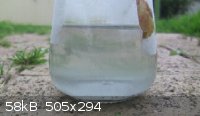
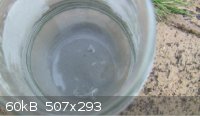
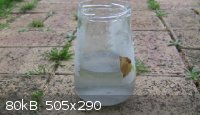
2nd Synthesis
Chlorination of hot Sodium Hydroxide
In this synthesis more then one chemical reaction is taking place at the same time... im using impure Manganese dioxide for this so it is hard to
weigh out the correct amount to get the other amounts right... So im adding HCl to the manganese dioxide to form Chlorine gas which is then passed
through a hot solution of Sodium Hydroxide, this forms a solution of Sodium Chloride and Sodium Chlorate aswell as water.
2MnO<sub>2</sub> + 8HCl = 2MnCl<sub>2</sub> + 3Cl<sub>2</sub> + 4H<sub>2</sub>O
6NaOH + 3Cl<sub>2</sub> = NaClO<sub>3</sub> + 5NaCl + 3H<sub>2</sub>O
Now the solution has turned a noticeable yellow colour which im guessing is from dissolved Chlorine in the water but that shouldn't be too much of a
issue...
I don't want Sodium Chlorate due to its hard to separate from the chloride so i wanna make Potassium Chlorate instead
so my question is should i boil/evaporate the solution until crystals appear b4 adding the potassium chloride?? then i just poor of the solution,
discard the crystals and then make a saturated solution of Potassium Chloride and transfer the solution in to the Sodium Chlorate with out
transferring the KCl crystals that hadn't dissolved... this will replace the sodium chlorate with the chloride to form potassium chlorate and sodium
chloride... then i just stick the solution into the freezer, only around 3 grams of potassium chlorate is soluble at 0 degrees C so i just filter and
wash the chlorate
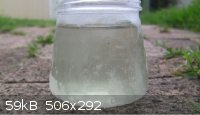
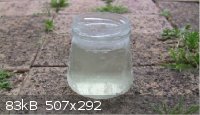
|
|
|
SmashGlass
Hazard to Self
 
Posts: 52
Registered: 25-1-2011
Location: Scandinavia
Member Is Offline
Mood: No Mood
|
|
2nd synthesis - It would probably be better to collect the crystallized sodium
perchlorate first, even if it is contaminated with some NaCl.
Then do the reaction with KCl. You will only get small quantities, but it's
better then nothing I guess.
I'm not sure whether your method would be an improvement as you are
creating even more NaCl and it might also salt out.
Experimentation is always the ultimate proof.
An even better way to make it would be from KOH using your first method.
Wood ash contains reasonable quantities of potassium. Hydroxide and carbonate.
There are plenty of sources on-line for the conversion of K2CO3 to to KOH.
It might work better in vegemite jars too! 
Good luck and happy tinkering.
If it ain't broke don't fix it....
Now where are my screwdrivers?  |
|
|
Chemistry Alchemist
Hazard to Others
  
Posts: 403
Registered: 2-8-2011
Location: Australia
Member Is Offline
Mood: No Mood
|
|
When does Perchlorate come into this? i didnt think it made perchlorate, ill let it evaporate a bit first b4 i add the potassium chloride, i have some
potassium hydroxide (finally) so i could aways give it a go, i was gonna make Potassium nitrate out of it but Potassium Chlorate is a better oxidizer

ps: i dont like vegemite 
|
|
|
bbartlog
International Hazard
    
Posts: 1139
Registered: 27-8-2009
Location: Unmoored in time
Member Is Offline
Mood: No Mood
|
|
Perchlorate does not come into this. Further, the initial product of bubbling chlorine into NaOH is not sodium chlorate, but sodium hypochlorite (and
sodium chloride as you suggested). You've made bleach! Now, over time, it's true that sodium hypochlorite disproportionates into NaCl and NaClO3
(months, maybe years at RT... boiling would help). If you had started with KOH, then the disproportionation into KCl and KClO3 would be pretty much
immediate.
|
|
|
Chemistry Alchemist
Hazard to Others
  
Posts: 403
Registered: 2-8-2011
Location: Australia
Member Is Offline
Mood: No Mood
|
|
Bubbling Chlorine into Sodium Hydroxide could cause 2 things, A cold solution will yield Sodium hypochlorite while a hot solution will yield sodium
chloride and sodium chlorate... the whole time i was bubbling chlorine, the solution was hot... wouldnt that mean sodium chlorate has formed?
|
|
|
TheNaKLaB
Hazard to Self
 
Posts: 51
Registered: 18-9-2011
Location: Australia
Member Is Offline
Mood: Elastic
|
|
Would the gray colour formed during your synthesis of Sodium Thiosulfate be caused from the sulfur-paper wick? The wick would contaminate the solution
with Carbon and other materials, wouldn't it? It really depends on how long you burnt the wick for aswell.
|
|
|
Chemistry Alchemist
Hazard to Others
  
Posts: 403
Registered: 2-8-2011
Location: Australia
Member Is Offline
Mood: No Mood
|
|
this time i used just foil to hold the sullfur instead so it wouldnt be from the wick... and carbon would be black, not really gray :S
|
|
|
SmashGlass
Hazard to Self
 
Posts: 52
Registered: 25-1-2011
Location: Scandinavia
Member Is Offline
Mood: No Mood
|
|
Oops! My bad
sorry about writing perchlorate.
-I had a brain fart-
chlorate is correct. 
Apologies
If it ain't broke don't fix it....
Now where are my screwdrivers?  |
|
|
woelen
Super Administrator
        
Posts: 7977
Registered: 20-8-2005
Location: Netherlands
Member Is Offline
Mood: interested
|
|
Quote: Originally posted by bbartlog  | | Now, over time, it's true that sodium hypochlorite disproportionates into NaCl and NaClO3 (months, maybe years at RT... boiling would help). If you
had started with KOH, then the disproportionation into KCl and KClO3 would be pretty much immediate. |
A
solution of KOH does not have different disproportionation properties than a solution of NaOH. In both cases there is slow disproportionation of
hypochlorite to chlorate and chloride at room temperature and faster disproportionation when the solution is heated.
The speed of disproportionation can be further increased if the pH is adjusted, such that most of the hypochlorite exists as HOCl instead of free
OCl(-) ion. In commercial chlorate electrolysis cells the pH is constantly adjusted and this is done in order to increase the speed of
disproportionation.
|
|
|
Chemistry Alchemist
Hazard to Others
  
Posts: 403
Registered: 2-8-2011
Location: Australia
Member Is Offline
Mood: No Mood
|
|
What way would i need to adjust the disproportionate? More acidic or basic? and how much faster would it disproportionate?
|
|
|
TheNaKLaB
Hazard to Self
 
Posts: 51
Registered: 18-9-2011
Location: Australia
Member Is Offline
Mood: Elastic
|
|
If it is a small amount of carbon contamination, the solution would turn grey. It seems like the only logical explanation 
|
|
|
Chemistry Alchemist
Hazard to Others
  
Posts: 403
Registered: 2-8-2011
Location: Australia
Member Is Offline
Mood: No Mood
|
|
So just filter it off and continue with the synthesis... would it matter if i add too much sulfur dioxide to the solution just to make sure all the
sodium hydroxide reacts?
|
|
|
TheNaKLaB
Hazard to Self
 
Posts: 51
Registered: 18-9-2011
Location: Australia
Member Is Offline
Mood: Elastic
|
|
Yeah filter it off. I would make sure that all the Sodium Hydroxide has reacted with the Sulfur Dioxide.
|
|
|
woelen
Super Administrator
        
Posts: 7977
Registered: 20-8-2005
Location: Netherlands
Member Is Offline
Mood: interested
|
|
If too much SO2 is passed into the liquid, then you obtain a solution of sodium bisulfite and in such a solution you hardly will be able to have any
sulphur dissolved. It is best to pass in SO2 until the liquid reeks of SO2 (the liquid then contains bisulfite) and then to this liquid add
NaOH-solution dropwise until the pH of the liquid is slightly basic (e.g. pH equal to 9 or 10). Use pH paper for testing this.
Keep in mind that the dissolving of sulphur in a solution of Na2SO3 also is a slow process. You will need heating of the liquid and long stirring.
|
|
|
Chemistry Alchemist
Hazard to Others
  
Posts: 403
Registered: 2-8-2011
Location: Australia
Member Is Offline
Mood: No Mood
|
|
So i think my Potassium Chlorate synthesis may of failed but i did get a slight precipitate so ill check that out later.
For now i took my sodium sulfite solution and filted it, i then added sulfur to the liquid and heated, it started to dissolve and the solution turned
a deep read... does that mean it was dissolving into he solution? i took it off heat after about 30 min of strong heating, filtered the insoluble
sulfur that didnt dissolve and now i have a deep red solution... how to i find out if Sodium thiosulfate is in? do i boil down the solution until
crystals appear then put it in the freezer to squeeze out thiosulfate for a kinda pure product and then just let it evaporate to get more crystals? is
the solution even ment to be deep red?
|
|
|
Chemistry Alchemist
Hazard to Others
  
Posts: 403
Registered: 2-8-2011
Location: Australia
Member Is Offline
Mood: No Mood
|
|
I boiled down the Thiosulfate solution untill crystals appeared, i then took off heat and let it cool, alot of crystals formed so i began to filter
(the crystals are badly impure... they are a yellowish brown colour) i then went to test the filtered solution to see if it contains any thiosulfate,
so i added HCl to it... solution turned white and then a pale yellow with lots of bubbling and the distinct smell of rotten eggs. would this indicate
the crystals are in fact thiosulfate?
|
|
|
AJKOER
Radically Dubious
    
Posts: 3026
Registered: 7-5-2011
Member Is Offline
Mood: No Mood
|
|
On the preparation of KClO3, first note that the disproportionation reaction proceeds on HClO as well:
3 HClO --> 2 HCl + HClO3 [1]
Boiling is not necessary, I would heat to around 70 C for an hour (following the suggested process for NaClO3 production from NaClO). Now add K2CO3,
for example, and your done.
2 HClO3 + K2CO3 -->2 KClO3 + H2O + CO2 (g)
As dilute HClO solutions are reported to be more stable, the more concentrated the HClO I would suspect the more rapid the formation of HClO3. There
is also a secondary decomposition reaction (general under 20% with 80% per reaction [1], but light and certain catalysts can accelerate):
2 HClO --> O2 + 2 HCl
Note, HClO can be made by adding a weak acid like vinegar (HAc), or a very dilute mineral acid, to NaClO:
NaClO + HAc --> NaAc + HClO
Then, distill off half of the solution and you will also double the concentration of the pure HClO (most of the Cl2O comes over early in the
distillation).
Note, I also believe (?) I read that HClO3 itself will further disproportionate into HClO4 (I will see if I can find the reference).
Do all work in a well ventilated area!
|
|
|
hissingnoise
International Hazard
    
Posts: 3940
Registered: 26-12-2002
Member Is Offline
Mood: Pulverulescent!
|
|
Chlorates are produced by disproportionation of hypochlorite salts!
It's neither desirable nor necessary to liberate acid!
High purity NaClO<sub>3</sub> disproportionates slowly to perchlorate and chloride when the salt is fused under controlled conditions.
Dust and organic material must be excluded, otherwise runaway decomposition will occur . . .
|
|
|
AndersHoveland
Hazard to Other Members, due to repeated speculation and posting of untested highly dangerous procedures!
    
Posts: 1986
Registered: 2-3-2011
Member Is Offline
Mood: No Mood
|
|
Actually, a solution of hypochlorous acid will not disproportionate into chloric acid. The reaction (actually an equilibrium) is:
(8)HOCl <==> (4)H2O + (2)ClO2 + (3)Cl2
These types of reactions can be very confusing, because of the many different equilibriums, which can shift depending on pH and reactant ratios. In
fact, in this reaction there will be some chloric acid in equilibrium, but its presence will not be favorable.
(2)H2O + (4)ClO2 <==> HOCl + (3)HClO3
There are many different ways this equilibrium could be written, and despite the different equations appearing with completely different reactants and
products, they are all essentially describing the same reaction equilibrium.
This is actually true. The chloric acid must be fairly concentrated (>40%) for this to procede.
Concentrated acid can disproportionate chlorate salts into perchlorate. [nitric acid should be used, not sulfuric acid which could result in an
explosive reaction]
see: http://www.sciencemadness.org/talk/viewthread.php?tid=4077#p...
| Quote: |
Journal für praktische Chemie, Volume 23
(16)KClO3 + (12)HNO3 --> (4)KClO4 + (12)KNO3 + (6)Cl2 + (13)O2 + (6)H2O
|
[Edited on 19-11-2011 by AndersHoveland]
|
|
|
Formatik
National Hazard
   
Posts: 927
Registered: 25-3-2008
Member Is Offline
Mood: equilibrium
|
|
Boiling aq. commercial NaClO to get get chlorate works only with difficultly. I've done it many times. I've even boiled to dryness (only in glass of
course, metal gets attacked) many times and hypochlorite still lingers especially because of the hydroxide that's added to stabilize the ClO-. This
hydroxide concentrates upon boiling.
I've mixed concentrated solutions of this ClO- filtrate with saturated KCl. The filtrate is very corrosive to filter paper and eats through it and
weakens its structure. Even after washing formed KClO3 (crystallized from the freezer) with water several times, the filter paper shows strong
weakening and crumbling. Because of strong hypochlorite presence, chlorate reduces in yield because of the many necessary water washes.
Bottom line: despite boiling, a significant amount of the hypochlorite does not decompose, and so the yields tend to be even more miserable.
A way to likely remedy this is to let the boiled mixture sit in a warm place (away from sunlight, I think I read somewhere in Gmelin sunlight
decomposes ClO- to NaCl and O2) several days or weeks until it decomposes on its own. The indicator of decomposition here would be obvious loss of
hypochlorite odor.
I would forget about attempting to neutralize the acid, it could need a very skilled balance, and hours in the lab of determination.
The preparation of hypochlorous acid from a chloride of lime of known concentration of hypochlorite and calcium oxide/hydroxide and very dilute
mineral acids was brought up in this following hypochlorous acid thread in the first attached reference: http://www.sciencemadness.org/talk/viewthread.php?tid=12869 Too much dilute acid and the hypochlorite converted entierly to Cl2 with variations
between HClO and Cl2 depending on the amount, with conversion entierly to HClO also possible.
|
|
|
woelen
Super Administrator
        
Posts: 7977
Registered: 20-8-2005
Location: Netherlands
Member Is Offline
Mood: interested
|
|
AJKOER is right to some extent. If you want to make chlorate at a reasonable reaction rate from hypochlorites, then _some_ acid must be present.
Strongly alkaline ClO(-) hardly disproportionates. In commercial electrolysis cells great effort is put in controlling the pH of the solution, such
that part of the hypochlorite is present as HOCl and part as ClO(-). In a home-made electrolysis cell this is difficult and pH usually is too high.
In an electrolysis cell this leads to loss of 1/3 of current efficiency, because no disproportionation takes place in solution and all ClO(-) must be
oxidized at the anode to ClO3(-). At the right pH (around 6), the ClO(-) disproportionates in solution and no additional oxidation is needed at the
anode.
If no electrolytic process is used, but simply heating of hypochlorite solutions, then one should adjest the pH to around 6 and then start heating.
Too high a pH is not desirable, as that will lead to loss of Cl2 (and possibly some ClO2 as well). So, in practice the method of making chlorate from
solutions of hypochlorite is less straightforward than many people think it is. A good way to adjust pH is to use boric acid. Dilute hydrochloric acid
can also be used, but that should be added dropwise under vigorous stirring and realtime pH monitoring.
|
|
|
Chemistry Alchemist
Hazard to Others
  
Posts: 403
Registered: 2-8-2011
Location: Australia
Member Is Offline
Mood: No Mood
|
|
Could we possibly talk about the purification of my Sodium Thiosulfate? i know i have made it but it is still a deep yellow colour... is there anyway
of purifying it?
|
|
|
ScienceSquirrel
International Hazard
    
Posts: 1863
Registered: 18-6-2008
Location: Brittany
Member Is Offline
Mood: Dogs are pets but cats are little furry humans with four feet and self determination! 
|
|
Dissolve it in water, boil with a little charcoal, filter and recrystallise.
|
|
|
Chemistry Alchemist
Hazard to Others
  
Posts: 403
Registered: 2-8-2011
Location: Australia
Member Is Offline
Mood: No Mood
|
|
The only charcoal I have is from burn wood... Would this work?
|
|
|
ScienceSquirrel
International Hazard
    
Posts: 1863
Registered: 18-6-2008
Location: Brittany
Member Is Offline
Mood: Dogs are pets but cats are little furry humans with four feet and self determination! 
|
|
I don't know.
Years ago we had decolourising charcoal which was finely ground willow charcoal, I think. It got the gunk out of all sorts of things.
|
|
|
| Pages:
1
2 |